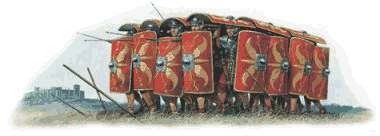Dolabra (pick axe)
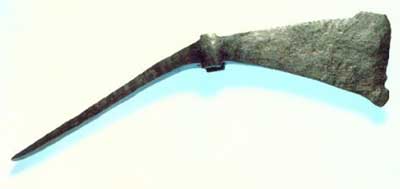 The dolabra is a versatile pioneer (what the rest of the world calls engineer troops —
deal with it) tool used in Italy since ancient times. Similar to a modern pickaxe, it had a broad axe
head on one side of the handle and a pick on the other.
The dolabra is a versatile pioneer (what the rest of the world calls engineer troops —
deal with it) tool used in Italy since ancient times. Similar to a modern pickaxe, it had a broad axe
head on one side of the handle and a pick on the other.
The dolabra was used in excavations and mines, as a priest's implement for religious animal sacrifices, and was used as an entrenching tool by the Roman legions. However, it was also useful as an improvised weapon if the user was attacked and could not reach his usual weapons. The weight of the weapon combined with the force of a swing concentrated on the sharp pick could inflict serious, often fatal injuries.
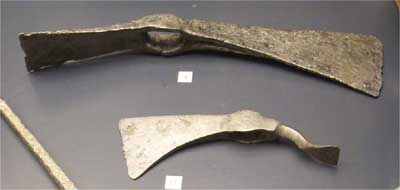 Since the Roman soldiers were combat engineers as much as (if not more than)
they were warriors, it is likely they used this tool more often than any weapon. They would chop down
trees to build forts and could dig with it...
Since the Roman soldiers were combat engineers as much as (if not more than)
they were warriors, it is likely they used this tool more often than any weapon. They would chop down
trees to build forts and could dig with it...
Dolabra sheath
A complete bronze Legionary Dolabra or Pick-axe sheath. A central section that acts as the axe edge cover is decorated in multiple ways. One edge is somewhat smooth with minor indents along it. The opposite edge however has a zig-zag triangular pattern along it. This center section also has a punched out design, either of repeating hearts or triangles. This is similar in style to the Gladius Locket/plate. Two holes on either side may have been a mounting point to house a soft padding inside to maintain the axes edge.
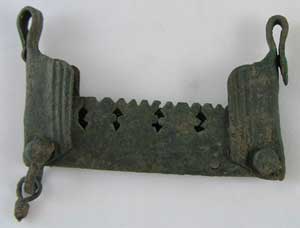 On each side of the central section are two pieces with a looped end. These symmetric pieces are also decorated with
three ridged lines that run perpendicular to the central section. A large rounded rivet holds each of these
loops in place, and allow them to move open to accept the axe head.
On each side of the central section are two pieces with a looped end. These symmetric pieces are also decorated with
three ridged lines that run perpendicular to the central section. A large rounded rivet holds each of these
loops in place, and allow them to move open to accept the axe head.
On one of these loops an extra pendant is attached with a twisted wire. Possibly once holding a more elaborate pendent such as a colored bead or leaf shaped piece of metal.
This sheath was meant to protect the sharp axe end of the Pick-axe. The Pick-axe was a standard piece of a Legionary's equipment that had a practical purpose. The Legion/army at the end of the days march would always dig a rampart/earth wall around the camp to protect it from attack while they slept at night. The Dolabra was constantly in use to fulfill this need and would also have served as a back up weapon in the event of a surprise attack. The loops of the sheath would have held a strap that when tightened against the opposite end of the axe would have held it in place. It was not uncommon for these Sheaths to be decorated with beads, and pendants that most likely would have jingled while on the march.
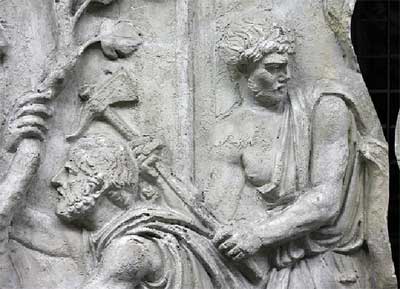
Dolabra in use art from Trajan's Column







